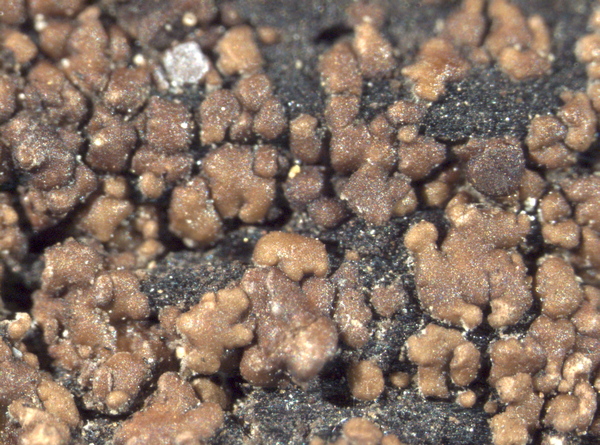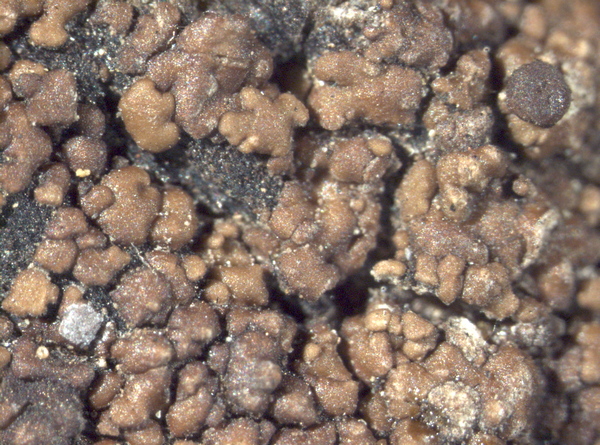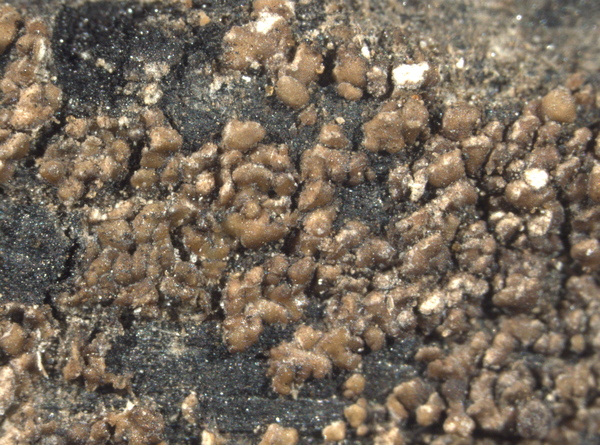Carbonicola myrmecina (Ach.) Bendiksby & Timdal
Taxon, 62: 950, 2013. Basionym: Lecidea scalaris var. myrmecina Ach. - Meth. Lich.: 78, 1803.
Synonyms: Hypocenomyce castaneocinerea (Räsänen) Timdal; Psora cladonioides var. castaneocinerea Räsänen; Psora myrmecina (Ach.) Boistel
Distribution: S - Camp (Aprile & al. 2003), Cal (Puntillo 1996).
Description: Thallus squamulose, greenish brown to deep chestnut brown, shiny, sorediate. Squamules up to 0.8(-1.3) mm wide, ascending, geotropically oriented, at first weakly convex, later moderately convex to bullate, with a concolorous, sometimes sorediate margin, the soredia farinose o granulose, arranged in labriform, brown soralia. Cortex up to 110 µm thick (including an up to 50 µm thick epinecral layer), of thick-walled hyphae with thread-like lumina; medulla white, I-. Apothecia rare, lecideine to biatorine, up to 0.5(-0.7) mm across, mainly marginal or developing on the underside of squamules, often coalescing, with a dark brown, convex, epruinose disc, and a soon excluded proper margin. Proper exciple of closely conglutinated, thin-walled hyphae with ellipsoid to short-cylindrical lumina, pale brown in outer part, colourless within, without crystals, K-, N-; epithecium brown, K-, N-; hymenium colourless, 40-50 µm high; paraphyses sparingly branched and anastomosing, 2-2.5 µm thick at mid-level, with swollen and dark-capped apical cells; hypothecium colourless. Asci 8-spored, clavate, without an apical amyloid cap, with a well-developed, amyloid tholus containing a deeper amyloid tube. Ascospores 1-celled, narrowly ellipsoid to fusiform, 7-13 x 2-2.5 µm. Pycnidia sessile, black, mostly marginal, with a brown wall. Conidia filiform, slightly curved, 7-11 x c. 1 µm. Photobiont chlorococcoid. Spot tests: cortex K-, C-, KC-, P-, UV-; soralia and medulla K-, C-, KC+ purple, P-, UV+ blue-white. Chemistry: colensoic acid, 4-O-methylphysodic acid and related compounds.Note: a cool-temperate to boreal-montane lichen found on charred wood; probably present also in the Alps, and to be looked for there. It is included in the Italian red list of epiphytic lichens as “Endangered” (Nascimbene & al. 2013c).
Growth form: Squamulose
Substrata: lignum
Photobiont: green algae other than Trentepohlia
Reproductive strategy: mainly asexual, by soredia, or soredia-like structures (e.g. blastidia)
Commonnes-rarity: (info)
Alpine belt: absent
Subalpine belt: absent
Oromediterranean belt: absent
Montane belt: extremely rare
Submediterranean belt: extremely rare
Padanian area: absent
Humid submediterranean belt: extremely rare
Humid mediterranean belt: absent
Dry mediterranean belt: absent

Predictive model
Herbarium samples
Growth form: Squamulose
Substrata: lignum
Photobiont: green algae other than Trentepohlia
Reproductive strategy: mainly asexual, by soredia, or soredia-like structures (e.g. blastidia)
Commonnes-rarity: (info)
Alpine belt: absent
Subalpine belt: absent
Oromediterranean belt: absent
Montane belt: extremely rare
Submediterranean belt: extremely rare
Padanian area: absent
Humid submediterranean belt: extremely rare
Humid mediterranean belt: absent
Dry mediterranean belt: absent

Predictive model
| Herbarium samples |
 Index Fungorum
Index Fungorum
 GBIF
GBIF





